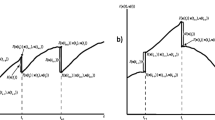Abstract
The paper discusses research aiming at the development of a management scheduling model for even-aged stands that may take into consideration fuel treatments to address the risk of wildfires. A Stochastic dynamic programming (SDP) approach is proposed to determine the policy (e.g. the fuel treatment and thinning schedules and the rotation age) that produces the maximum expected discounted net revenue. Fuel treatment activities encompass shrub cleanings. Emphasis was on combining a deterministic stand-level growth and yield model with wildfire occurrence and damage models to design a SDP network. SDP stages are defined by age and state variables include both the stand basal area and the number of years since the last fuel treatment. Fire occurrence and damage scenarios are addressed at each stage. Results from an application to Maritime pine (Pinus pinaster Ait.) stand management scheduling in Leiria National Forest, Portugal, are presented. Results suggest that the modeling strategy may help assess the impact of wildfire risk on the optimal stand management schedule. They confirm that the maximum expected discounted net revenues decreases. Further, albeit some timber may be salvaged after the wildfire, rotation age also decreases when the risk of fire is considered. Finally, they provide interesting insights about the role of thinning and fuel treatment policies in mitigating risk.
Similar content being viewed by others
References
Amacher, G. S., Malik, A., & Haight, R. (2005). Not getting burned: the importance of fire prevention in forest management. Land Economics, 81, 284–302.
Amacher, G. S., Ollikainen, M., & Koskella, E. (2009). Economics of forest resources. Cambridge: MIT Press, 397 p.
Amidon, E. L., & Akin, G. S. (1968). Dynamic programming to determine optimal levels of growing stock. Forest Science, 14, 287–291.
Arthaud, G. J., & Klemperer, W. D. (1988). Optimizing high and low thinnings in loblolly pine with dynamic programming. Canadian Journal of Forest Research, 18, 1118–1122.
Borges, J. G., & Falcão, A. (1999). Programação dinâmica e gestão de povoamentos com estrutura regular e composição pura. In Aplicação à mata nacional de Leiria. Revista florestal XII (Vol. 1/2, 69–82).
Botequim, B., Borges, P., Carreiras, J., Oliveira, M. M. O., & Borges, J. (2009). Development of a shrub growth model in understory conditions (preliminary model) (Technical Report—7, FORCHANGE). Instituto Superior de Agronomia, Lisboa (in preparation).
Brodie, J. D., Adams, D. M., & Kao, C. (1978). Analysis of economic impacts on thinning and rotation for Douglas-fir using dynamic programming. Forest Science, 24, 513–522.
Dieter, M. (2001). Land expectation values for spruce and beech calculated with Monte Carlo modelling techniques. Forest Policy and Economics, 2, 157–166.
Englin, J. P., Boxall, P., & Hauer, G. (2000). An empirical examination of optimal rotations in a multiple-use forest in the presence of fire risk. Journal of Agricultural and Resource Economics, 25, 14–27.
Falcão, A. (1998). DUNAS—A growth model for the National Forest of Leiria. In Proceedings of IUFRO workshop empirical and process-based models for forest tree and stand growth simulation, September 21–27, Oeiras.
Ferreira, L. (2011). Doctoral thesis. In preparation.
Forsell, N., Wikström, P., Garcia, F., Sabbadin, R., Blennow, K., Högström, M., & Eriksson, L. O. 2009. Risk management of wind damage in forest management: A Graph-based Markov Decision Process approach. Annals of Operations Research. Published online: 05 February 2009.
Garcia-Gonzalo, J., Marques, S., Borges, J. G., Botequim, B., Oliveira, M. M., Tomé, J., & Tomé, M. (2011, in press). A three-step approach to post-fire mortality modeling in Maritime pine (Pinus pinaster Ait) stands for enhanced forest planning in Portugal. Forestry.
González, J. R., Palahi, M., & Pukkala, T. (2005). Optimizing the management of Pinus sylvestris L. stand under the risk of fire in Catalonia. Les Ulis Cedex A: EDP Sciences.
Gunn, E. (2005). A neuro-dynamic programming approach to the optimal stand management problem. In M. Bevers & T. M. Barrett (Eds.), Comps. systems analysis in forest resources: proceedings of the 2003 symposium (pp. 265–272). General Technical Report PNW-GTR-656. Portland OR. U.S. Department of agriculture, Forest Service, Pacific Northwest Research Station.
Haight, R. G., & Smith, W. D. (1991). Harvesting loblolly pine plantations with hardwood competition and stochastic prices. Forest Science, 37, 1266–1282.
Haight, R. G., Brodie, J. D., & Dahms, W. G. (1985). A dynamic programming algorithm for optimization of lodgepole pine management. Forest Science, 31, 321–330.
Hoganson, H. M., Borges, J. G., & Wei, Y. (2008). Coordinating management decisions of neighboring stands with dynamic programming. In K. von Gadow & T. Pukkala (Eds.), Managing forest ecosystems: Vol. 15. Designing green landscapes (pp. 187–214). Berlin: Springer.
Kennedy, J. (1986). Dynamic programming: applications to agriculture and natural resources (pp. 27–77). London: Elsevier Applied Science, 244–264.
Lohmander, P. (1989). Stochastic dynamic programming with a linear programming subroutine: application to adaptive planning and coordination in the forest industry enterprise. In P. Lohmander (Ed.), Scandinavian Forest Economics (Vol. 31, p. 51).
Marques, S., Borges, J. G., Garcia-Gonzalo, J., Moreira, F., Carreiras, J. M. B., Oliveira, M. M., Cantarinha, A., Botequim, B., & Pereira, J. M. C. (2010, in press). Characterization of wildfires in Portugal. European Journal of Forest Research.
Marques, S., Botequim, B., Garcia-Gonzalo, J., Borges, J. G., Tomé, M., & Oliveira, M. M. (2011, in press). Assessing wildfire risk probability in Pinus pinaster Ait. stands in Portugal. Forest Systems.
Martell, D. L. (1980). The Optimal Rotation of a flammable forest stand. Canadian Journal of Forest Research, 10, 30–34.
McDill, Marc E., & Amateis, Ralph L. (1992). Measuring forest site quality using the parameters of a dimensionally compatible height growth function. Forest Science, 38(2), 409–429.
Möykkynen, T., Miina, J., & Pukkala, T. (2000). Optimizing the management of a Piceaabies stand under risk of butt rot. For. Path., 30, 65–76.
Norstrom, C. J. (1975). A stochastic model for the growth period decision in forestry. The Swedish Journal of Economics, 77, 329–337.
Puterman, M. L. (2005). Markov decision processes: discrete stochastic dynamic programming. New York: Wiley-Interscience. ISBN 0471727822.
Reed, W. J. (1984). The effects of the risk of fire on the optimal rotation of a forest. Journal of Environmental Management, 11, 180–190.
Reed, W. J. (1987). Protecting a forest against fire: optimal protection patterns and harvest policies. Natural Resource Modeling, 2, 23–53.
Reed, W. J. (1993). The decision to conserve or harvest old-growth forest. In Ecological economics (Vol. 8(1), pp. 45–69). Amsterdam: Elsevier.
DGRF 2006. Resultados do IFN 2005/2006, Lisboa, 70 pp.
Routledge, R. D. (1980). The effect of potential catastrophic mortality and other unpredictable events on optimal forest rotation policy. Forest Science, 26(3), 389–399.
Thorsen, B., & Helles, F. (1998). Optimal stand management with endogenous risk of sudden destruction. Forest Ecology and Management, 108, 287–299.
Valsta, L. (1990). A comparison of numerical methods for optimizing even aged stand management. Canadian Journal of Forest Research, 20, 961–969.
Zhou, M., Liang, J., & Buongiorno, J. (2008). Adaptive versus fixed policies for economic or ecological objectives in forest management. Forest Ecology and Management, 254, 178–187.
Author information
Authors and Affiliations
Corresponding author
Rights and permissions
About this article
Cite this article
Ferreira, L., Constantino, M. & Borges, J.G. A stochastic approach to optimize Maritime pine (Pinus pinaster Ait.) stand management scheduling under fire risk. An application in Portugal. Ann Oper Res 219, 359–377 (2014). https://doi.org/10.1007/s10479-011-0845-z
Published:
Issue Date:
DOI: https://doi.org/10.1007/s10479-011-0845-z




